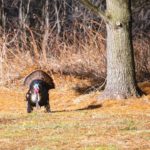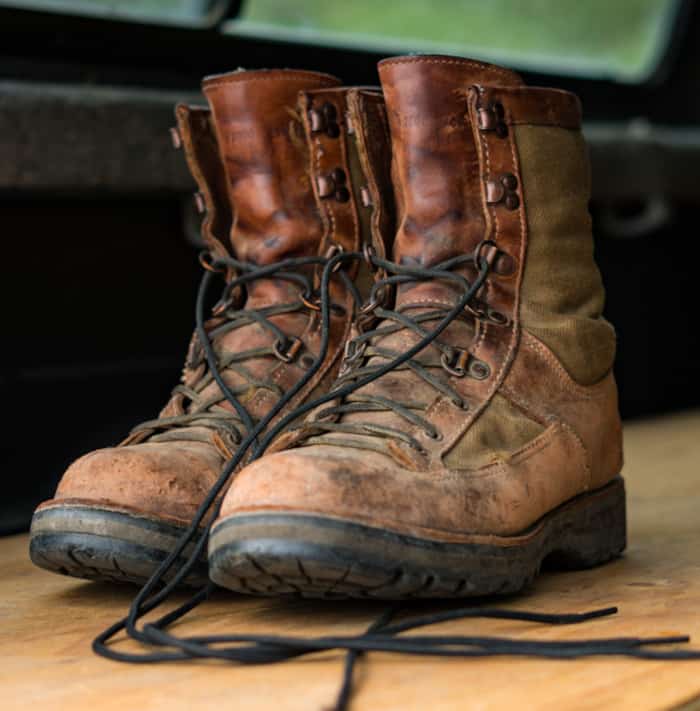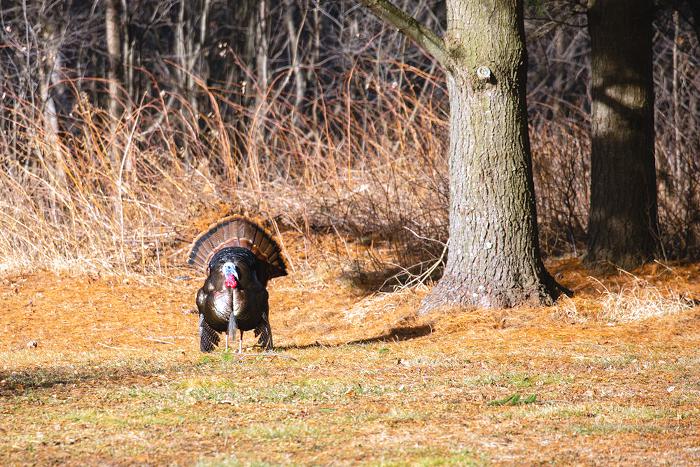If you’re a hunter, you know how important it is to have a good pair of hunting boots. But if you suffer from Plantar Fasciitis, you also know how difficult it can be to find a pair of comfortable and practical boots.
Luckily, we’ve done the research for you and compiled a list of the 5 best hunting boots for Plantar Fasciitis. So, whether you’re looking for something lightweight and breathable or waterproof and insulated, there’s sure to be a boot on this list that’s perfect for you.
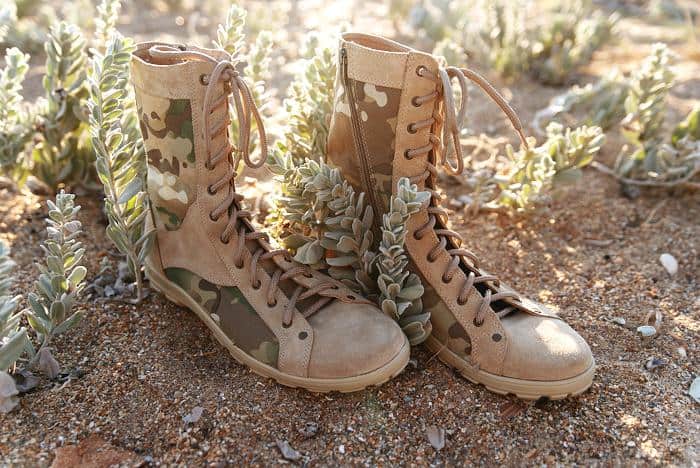
Before I discuss this topic, it’s time for a medical disclaimer:
MEDICAL DISCLAIMER:
The content posted on this website is for informational purposes only and is not intended as medical advice or as a substitute for the medical advice of a physician.
To be clear, I’m not a medical professional, and none of the staff at Hunter Gear have any specific medical training beyond basic first aid. As such, the information contained in the article as it relates to medical treatments or suggestions is merely for informational purposes.
What is Plantar Fasciitis?
Plantar Fasciitis is a term used to describe a condition in which the plantar fascia becomes inflamed or irritated. The plantar fascia is a thick band of tissue that runs across the bottom of each foot and connects the heel bone to the toes. This connective tissue (which is sometimes mistakenly called the Plantar Fascia ligament) helps support the arch of the foot when the foot is in motion.
Typically, Plantar Fasciitis is characterized by pain in the bottom of the foot or hell pain that occurs with each step. It can affect both feet and just one foot. In some cases, Plantar Fasciitis occurs during the first few steps taken when you first get up, but it may be an ongoing issue for others.
In some people, the condition may be mild and occasional, but, for others, it may be an ongoing issue that significantly impacts daily life.
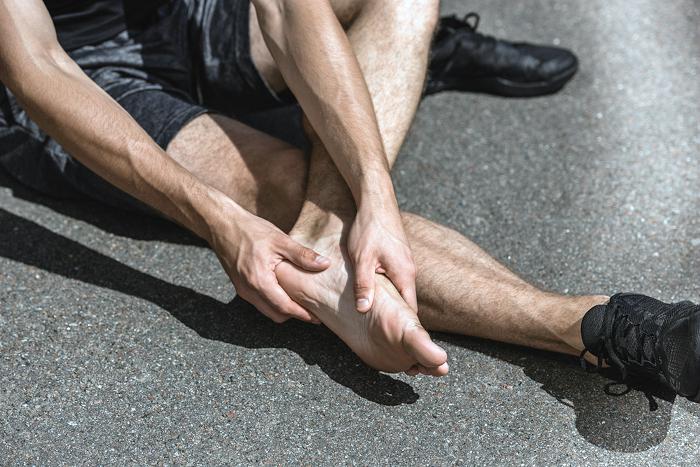
I’ve been dealing with Plantar Fasciitis for the last 15 years, which is one of the reasons that I was selected to author this post. My journey with Plantar Fasciitis began after a broken ankle that required surgery. After the ankle healed and I completed the physical therapy, the Fasciitis reared its ugly head in my surgically repaired foot.
It started out fairly minor but quickly escalated to a painful condition that interfered with my daily life. I had trouble walking and could not exercise, leading to unwanted weight gain. The added weight exacerbated the problem even more.
From a treatment perspective, I tried nearly everything, including:
- Physical therapy
- Custom-made orthopedic insert (which I’ll revisit later in the article)
- Injections to reduce the inflammation
- Oral steroids
- Night splints
Some solutions provided a little bit of relief, but most were only marginally effective.
Plantar Fasciitis Facts
Here are a few interesting facts and factoids about Plantar Fasciitis that you may not know:
- 10% of the world’s population will experience Plantar Fasciitis at some point in their lives.
- A person’s weight can play a significant role in Plantar Fasciitis since health experts have reported that obesity or being overweight has been causally linked to Plantar Fasciitis in 70% of the diagnosed cases.
- 80% of people with Plantar Fasciitis also have trouble with a specific foot movement called dorsiflexion. The dorsiflexion action is a movement where the toe end of the foot is brought up towards the shin.
- Age also plays a role in Plantar Fasciitis cases as the fascia tissue begins to lose elasticity during the aging process.
- Prolonged Plantar Fasciitis leads to another condition called Heel Spurs about 50% of the time.
- In studies, 98% of patients diagnosed with Plantar Fasciitis reported fasciitis foot pain during the first 5-10 steps after getting out of bed.
- From a physical activity perspective, runners have the highest incidences of Plantar Fasciitis across the different styles and types of exercise and sporting activities.
- According to the health statistics from the Centers for Disease Control and Prevention, there are nearly one million doctor visits in the U.S. annually attributed to Plantar Fasciitis.
Hunting Boots vs. Plantar Fasciitis
Between my treatments for Plantar Fasciitis and visits to various specialists, I learned a few things relevant to hunting with this Plantar Fasciitis affliction.
Here’s what I learned:
Boot Weight Matters
Boots with a heavy toe area (such as steel-toe boots) pull the toe area down as you walk, aggravating the Plantar Fascia. I had a pair of heavy-duty work boots (with a reinforced steel toe) that I wore for home improvement projects or any other project where I wanted additional protection for my feet.
The day after wearing those boots, my Plantar Fasciitis would flare up, making it very difficult to walk. At first. I thought the foot sole area inside the boots might be the problem. However, my podiatrist took a look at them and immediately indicated that the heavyweight toe area was causing my foot to pronate downward as the day wore on, inflaming the condition.
That’s not to say that you can’t have a heavier style hunting boot or hiking boot that works well with Fasciitis, but it needs to be evenly weighted.
So, when it comes to boots, evenly distributed weight or lightweight models with good arch support will offer the best results against Plantar Fasciitis.
The Boot Insole and Insole Arch Support are Important
Arch support plays a crucial role in preventing or minimizing Plantar Fasciitis, so finding a hunting boot with a good quality insole and arch support will be paramount if you suffer from Fasciitis.
You really have two options in this area:
- Find a good boot with a well-made insole and integrated arch support
- Buy the boots you like, then add an orthopedic insole designed to help with the Fasciitis.
Let’s discuss each option in more detail:
Find a Good Boot with a well-made insole and integrated arch support
Hunting boots are typically available in the following formats and price ranges:
- Entry Level/Budget Boots – Priced from $50 up to $149
- Mid-Range Boots – Priced from $150 to $300
- High-End Boots – Priced from $300 and up
My experience in the boot industry indicates that you typically won’t see a hunting boot with a well-made or high-quality insole and arch support for less than $150 or so.
Hunting boots are one of those areas where you get what you pay for in terms of quality and durability. Unfortunately, less expensive boots will typically be made to a lower quality with a shorter estimated lifespan.
More expensive hunting boots (like those in the mid-range to high-end categories) typically cost more, but are better made, have more features, and tend to last longer (if properly maintained).
Buy the boots you like, then add an orthopedic insole designed to help with the Fasciitis
In this scenario, you’re intentionally purchasing more entry-level or budget-friendly boots, with plans to add an aftermarket orthopedic insole insert to help with comfort and/or Plantar Fasciitis.
This approach isn’t necessarily flawed, as I’ve followed the same path a few times. However, the potential issue with this approach lies in finding a quality pair of inserts that fit the boots while helping the wearer with the Fasciitis issues.
Good quality inserts (and I’m not talking about the cheap drugstore Dr. Scholle’s type) are hard to find, can be challenging to fit your specific feet, and are not cheap. On the other hand, custom-made orthotic inserts are unbelievably expensive but are also very effective (at least in my experience). While most wearers opt for the low-cost versions, I prefer to meet in the middle and stick with semi-custom orthopedic inserts that are mid-range.
While I could write another complete article on aftermarket insoles, I’ll skip that for now and just share my favorite aftermarket insoles for hunting boots: Sole Heat Moldable Footbeds.
Top Five Hunting Boots for Plantar Fasciitis
You’re on this page to see boot recommendations to let’s get started. Here are my top five hunting boots that work best to reduce or manage Plantar Fasciitis:
Irish Setter 2870 Vaprtrek 8″ Non-Insulated Hunting Boots (Series 2830)
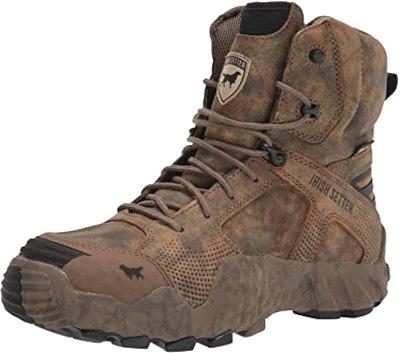
If you’re looking for a lightweight hunting boot that is waterproof yet durable, then the Vaprtrek boot series from Irish Setter might be worth checking out.
This particular boot is recommended primarily for one reason, and that’s they are one of the lightest boots on the market. The average weight per pair is 2 lbs. 4 ounces, equating to a single boot weight that averages out to 1 pound and 1 ounce per boot.
Since these boots are uninsulated, they are best for spring hunting or early fall season hunting. At 8 inches tall, they are tall enough to protect your feet from most issues but not so tall that they become cumbersome.
The factory insole is better than average in terms of design and quality, but an aftermarket insole may offer additional help with Plantar Fasciitis. The selling point of these boots is the overall lightweight, which helps keep the feet from pronating down as you step.
However, no boot is perfect, so here are a few pros and cons (in my opinion):
PROS | CONS |
|
|
Rocky Red Mountain Snake Boots (Series 2848)
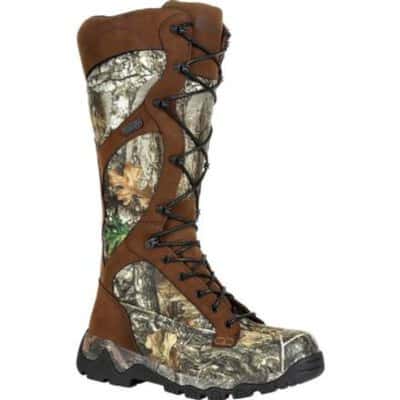
For most hunters, there will be a time when you are sharing the woods with snakes, including venomous species. In those situations, having a set of snake-proof hunting boots isn’t a bad idea. On a related note, I wrote a very detailed post that goes into great detail about the different types of snake-proof footwear on the market.
Most snake boots on the market are strong in the area of repelling snake bites but not so strong in the area of comfort and weight. Typically, snake boots loosely fall into one of two categories:
- Lightweight but questionable in the ability to repel a venomous snake bite
- Heavy duty that can easily withstand a snake bite but are overly heavy
These common weaknesses are an area where the Rocky Red Mountain snake boots differ from most as they are ultra-lightweight yet strong enough to repel a bite from any snake in the United States.
In addition to being lightweight, these Rocky snake boots also feature a solidly built insole with decent arch support. I ended up adding an aftermarket insole to mine more for comfort purposes versus Fascia issues.
A few of the lace-up snake boot models on the market have issues with the waterproofing above a certain height on the boot. However, I have not found that to be the case with these Red Mountain boots.
Here’s one more quick point I’d like to make about snake boots:
In recent years, zip-up models have become very popular because they are easier to put on and take off compared to lace-up boots. While zip-ups are more convenient, I prefer the old-fashioned lace-up models. If the zipper breaks on a zip-up model, then the boot has to be sent in for repair; if a lace breaks on a lace-up model, I can replace that on my own.
Here are a few pros and cons that I’ve noticed with this model of boot:
PROS | CONS |
|
|
Lacrosse Atlas 400 Gram Hunting Boots
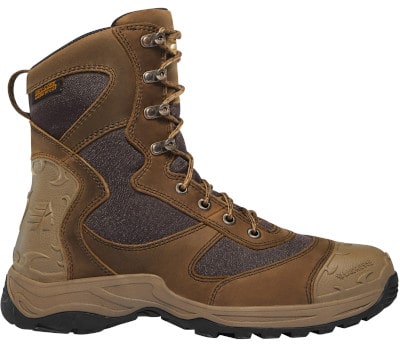
Most hunting seasons occur during the fall and winter, which means cooler or colder weather. Depending on the geography where you hunt, that can be range from mildly cool down to below freezing.
During these cooler or cold hunting conditions, uninsulated boots may not be enough to keep your feet warm. Colder weather is where insulated boots come into play and show their worth. Boot insulation is measured in grams, with the higher the gram weight equating to warmer boots. So, for example, a pair of hunting boots with 1200 grams of insulation will typically be warmer than boots with 400 grams of insulation.
With colder weather, hunters typically have two options for warm feet:
- Purchase hunting boots with low to mid-range insulation, then use heavy sockets or foot heat warmers to make up the needed warmth.
- Buy a pair of hunting boots with more insulation with fewer socks.
I’ve tried both approaches throughout my life, and neither is really a bad way to go. This is especially relevant if you are on a budget and can only afford one pair of hunting boots.
These LaCrosse Atlas hunting boots with 400 grams of insulation offer a nice insulation-to-cost ratio balance. At 400 grams, they can be worn with light socks for cooler weather and heavier socks for colder weather.
Note that the LaCrosse Atlas series of hunting boots are available in a variety of insulation options, including:
- Uninsulated
- 400 grams of insulation
- 800 grams of insulation
- 1200 grams of insulation
This variety covers almost every common hunting or weather scenario.
While these boots are only 8 inches tall, they are well made and feature a high arch in the insole.
Here are a few good and bad points with this boot model:
PROS | CONS |
|
|
Thorogood Infinity FD 9″ 800-gram Hunting Boots (Style Number 864-4189)
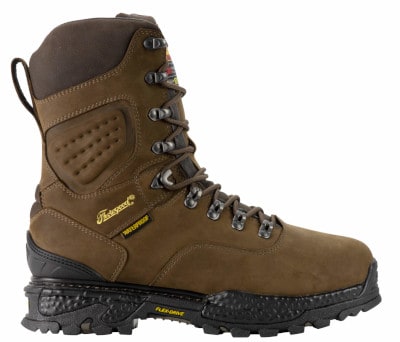
While the Thorogood line of boots is not as well known in the hunting industry as some of the other brands I’ve mentioned, they produce a very good hunting boot for the money.
The Thorogood Infinity FD series of hunting boots are 9 inches tall and features 800 grams of insulation. These boots are more geared towards colder weather hunting and weigh nearly twice as much as the other boots on this list. However, they also come with one of the most comfortable out-of-the-box insoles I’ve tested in the sub $300 price range.
The insole is very comfortable, and the arch support is superb. This insulated boot is one that I can wear without any type of aftermarket insole for my Plantar Fasciitis. In addition, the insole is removable and replaceable should it wear out or become damaged.
Here are a few things that I like and didn’t like with this series of boots:
PROS | CONS |
|
|
Kenetrek Everstep Orthopedic 400 Gram Hunting Boots
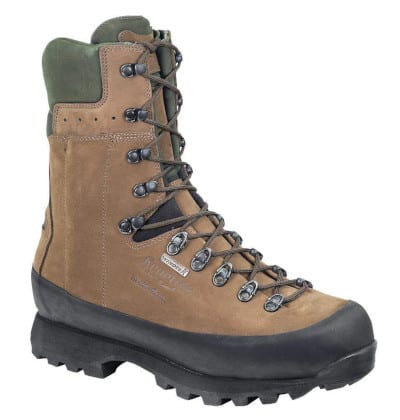
Kenetrek is a higher-end line of hunting boots based out of Bozeman, Montana. They were founded by a hardcore Sheep hunter named Jim Winjum. Kenetrek offers some of the best hunting boots on the market, but they come at a price, their cost.
Kenetrek boots are pretty costly compared to most of the mainstream boot brands that I’ve discussed so far. And I’m not talking a little bit more expensive; I’m talking double or triple the costs of some of the more budget-friendly boots on this page.
However, with Kenetrek, you get what you pay for, which is a very well-made and durable pair of boots that will last many years if properly maintained. And should you wear out a pair of Kenetrek boots, Kenetrek will resole and recondition them (for a fee, of course). That repair and reconditioning program is not a common approach for most commercial boot manufacturers, which says something about the Kenetrek quality.
Kenetrek offers a hunting boot series called the Everstep Orthopedic series, which is the most comfortable boot that I’ve worn to date. They are a top-tier boot that will do wonders for Plantar Fasciitis.
Another thing to be aware of with Kenetrek boots in addition to the price: They absolutely require a break-in period before they are ready to wear in the field. And I’m not talking about wearing them around the house for a few hours; I’m talking about wearing them for days before they are fully broken in.
Here are a few things that I noticed about these specific Kenetrek boots:
PROS | CONS |
|
|
Hunting Boots Guide
Finding the right pair of hunting boots can be challenging by itself but is even more difficult if you suffer from Plantar Fasciitis.
Here are a few factors to take into consideration when shopping for your next pair of hunting boots.
Boot Height
Depending on the boot manufacturer and specific boot style, hunting boots are offered in several different heights. Much like it sounds, the height describes how high the boot covers the ankle and calf, moving up towards the knee.
The numbers describing boot height are relatively self-explanatory:
- A 9″ boot means that the top of the boot is 9 inches tall from the ground.
- A 12″ boot is 12 inches tall from the ground.
Some specialized boots are taller than average. A great example of this is snake boots. To offer as much protection as possible, most snake boots are manufactured to be at least 18″ or 19′ inches tall, with some going as high as 20 inches.
9-12 inches tall is an average boot height for normal hunting conditions.
Material
Modern-day hunting boots are manufactured from several different materials or combinations of materials, including:
- Leather
- Ballistic Nylon
- Rubber
- Denier Nylon
A few even utilize a specialized material called Kevlar (which is the same patented material used in bulletproof vests).
Hunting boots are generally grouped into two categories from a materials standpoint:
- Field Boots
- Rubber Boots
Here’s a general overview of each boot style:
Field Boots
Field boots are boots made from leather or nylon or a combination of those two materials. This boot style is made to protect the feet and offers features like waterproofing, stability, and traction.
Depending on the conditions, field-style boots tend to be the more popular option for general hunting use.
Rubber Boots
As described, rubber boots are typically made from rubber and are sometimes called Muck boots or Muck boot (after the company that is credited with inventing this style of boot)
The rubber boot style is best known for being completely waterproof and offers traction in muddy or wet conditions. Rubber boots are more popular with hunters in swampy areas or those who duck hunt in tidal areas.
if you suffer from Plantar Fasciitis or flat feet, I generally recommend field-style boots over the rubber hunting boot styles because the field-style boots tend to have a better insole and arch support system.
Water Resistant vs. Waterproof Boots
If you’re going to be hunting around or near water, then it’s essential to pay attention to the water-based classification of boots. These classifications are generally assigned by the boot manufacturer and are part of the labeling of each boot.
Typically, they are classified or labeled as being either waterproof or water-resistant.
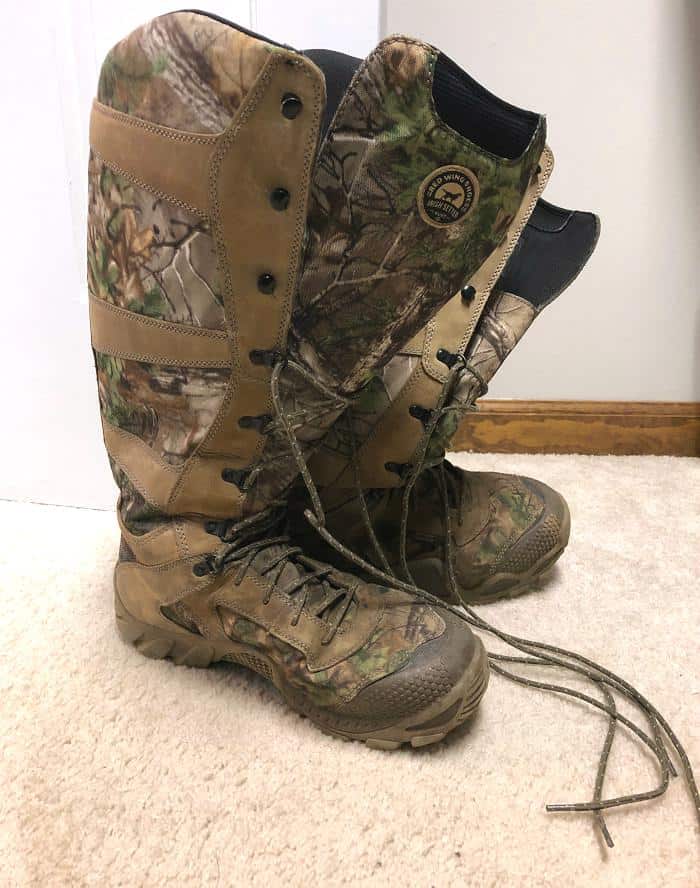
Waterproof
Waterproof is a term used to describe the process of making an object resist water ingress under specific circumstances.
In some cases, waterproofing is a native feature of the materials used in the production of an item. In other instances, waterproofing is a specific process applied to a product to render it waterproof.
Technically speaking, a boot labeled as “waterproof” is impervious to water under certain conditions. However, the waterproof label has conditions. For example, most hunting boots labeled as waterproof will only repel water up to a certain depth. So, a 12″ high boot may only be waterproof up to the first 10 inches.
Water Resistant
Water-resistant is a term used to describe the capacity to resist water but not repel it. In other words, being resistant to penetration by water but not waterproof as to repel water.
While most hunting boots are labeled “waterproof” to a certain degree, some are labeled “water-resistant.” Boots that are labeled or classified as being water-resistant will not repel water.
While the two terms are similar in description, they are very different applications. For example, boots marked as being waterproof should not allow water into the boot, while water resist boots may be waterproof when first exposed to water, but repeated exposure will lead to water entering the boot.
One more point worth mentioning regarding water resistance versus waterproofing:
Some people misunderstand the term waterproofing as they expect the boot to repel water under all circumstances, including when the entire boot is submerged underwater. As mentioned previously, waterproofing only applies to a certain height on boots. Any water that comes into contact with the boot over the waterproofing height may penetrate the boot.
My suggestion would be to focus on boots specifically marked as waterproof and skip the models marked as water-resistant.
All the boot models that I’ve suggested above are listed as waterproof.
Varying Levels of Insulation
Although I briefly touched on this topic above, it’s worth going into a bit more detail. Modern hunting boots are manufactured or offered in a variety of configurations and levels of insulation.
Most bootmakers use a material called Thinsulate™ that was developed and trademarked by the 3M Company in the early 1960s. Thinsulate™ is considered one of the warmest insulation materials on the market by thickness and weight. This material is lighter and thinner than any polyester material and provides significantly more warmth per gram.
With hunting boots, Thinsulate™ is commonly listed as a per gram number, with the higher numbers referring to more grams of Thinsulate™.
For example, a winter boot with 600 grams of Thinsulate™ insulation won’t be as warm as a pair of boots made with 1200 grams of Thinsulate™.
The level of insulation matters as you wouldn’t want to purchase a pair of uninsulated boots for a fall trip to Alaska or a pair of 1200-gram insulated boots for a hunting trip to Florida. Neither option would be an appropriate choice given the expected weather conditions of either example.
Proper Boot Sizing Matters
In addition to choosing the best hunting boots for your needs, you’ll also need to select the best or most appropriate boot size for your needs.
Most hunting boots are sized one of two ways:
True Size
You may also see this type of sizing listed as:
- Actual size
- Real size
In this scenario, if you wear a size 12 tennis shoe, then you would theoretically wear a size 12 hunting boot.
Most boots are sized this way, so choosing the right size is a more straightforward process. The potential issue with this approach is when you wear slightly different tennis shoe sizes across different brands. For example, I usually wear a 12 in Nike shoes but switch to a 12.5 in New Balance as the New Balance brand seems to run slightly smaller.
Hunting boots follow the same approach as not all manufacturers follow a universal sizing model. If you’re ordering online (which is typically where you’ll find the most competitive pricing), try to stick with vendors who offer a free or hassle-free exchange policy if you need to switch to a different size.
The other issue that I’ve encountered with the true sizing model involves the ability to utilize heavier or thicker socks for colder temperatures. If the boots are true-sized, then it could make sense for me to purchase a ½ size up to leave room for thicker or heavier socks during the colder weather.
Oversized
Some boot makers use a sizing approach called “oversized” where they build boots slightly larger than the specific size to accommodate thicker socks. In these types of sizing situations, the boots may be marked as:
- Running large
- Oversized
- Large sized
Boots marked in this manner suggest that they are already sized slightly larger than the normal sizing approach, so a hunter does not need to go up a half size to accommodate heavyweight socks or inserts for additional warmth.
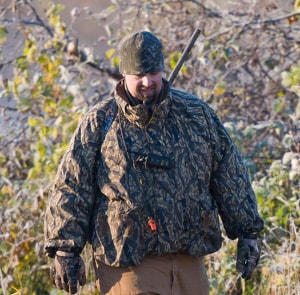
Ben was born and raised in the great state of Texas and comes from a long line of outdoorsmen. He grew up hunting nearly every game species that Texas had to offer, including wild pigs, White-tailed deer, and coyotes. While Ben is equally comfortable hunting almost any game species, his primary focus today is predator hunting and turkey hunting. He is also a long-range shooter and enjoys harvesting coyotes at longer than average distances. Ben started working in outdoor and sporting goods while in high school and now has 17 years of experience in the hunting industry, including some time as a part-time hunting guide. Ben is married with three boys, who are continuing the family hunting traditions.


